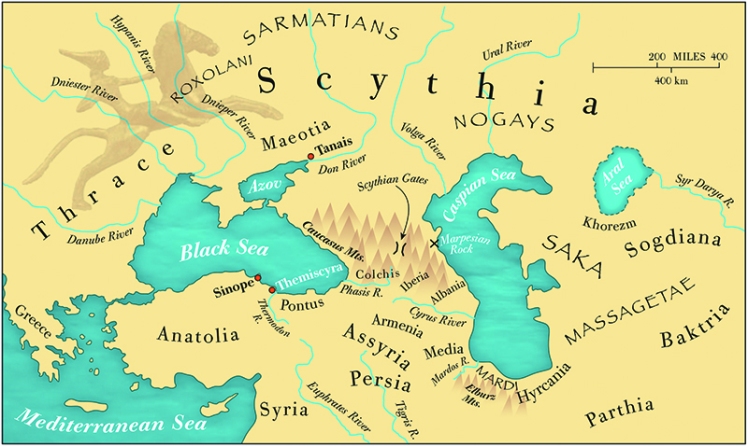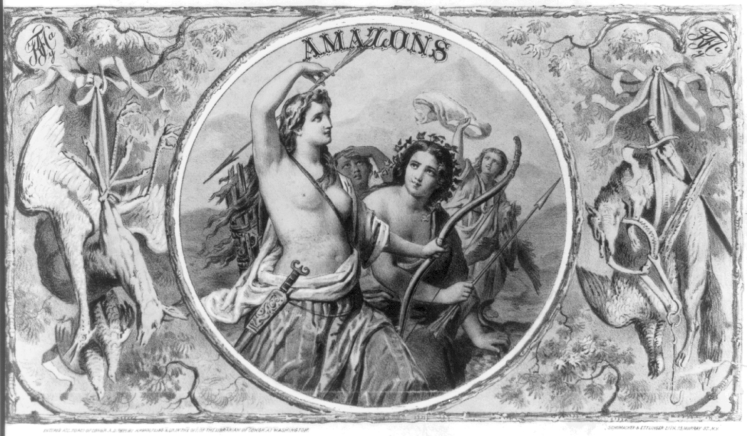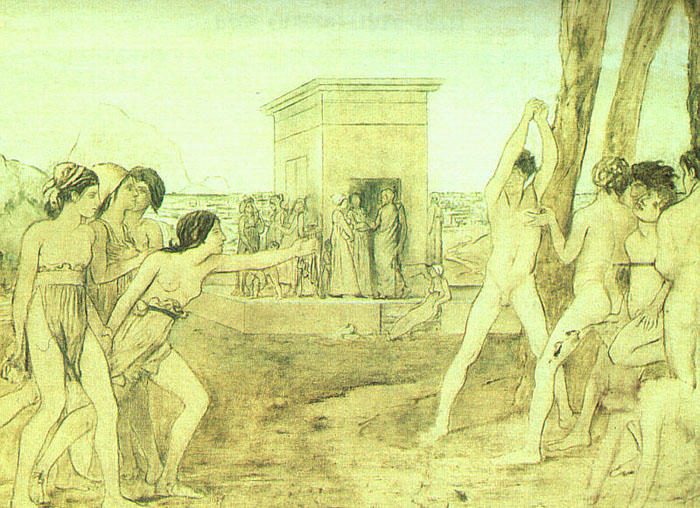***Please Note This Article Contains Nudity***
Abstract
In this digital essay, I will be examining the myth of the Amazons. I hope to accomplish this by examine a sample of the broad legend of the Amazons spread over many cultures and eons. My research will be broken into several different section:
- The Amazonian Origin – Origin myths from Greek and Roman culture
- Why Amazonian Myths? – How ancient cultures may have used Amazonian myths
- Why Amazons Persist – Why Amazonian myths continue to be popular
- Amazonian Society – How Amazonian society was depicted in legend
- Everyday Amazons – How Amazons compared to ancient women
- Modern Amazons – An example of Amazons in modern media
- Conclusion
By the end of this essay, I hope to have provided a wide range of information and understanding on the myth of the Amazons.
1 – The Amazonian Origin
The origin of the Amazons is not a historically unified narrative across cultures. The existence of the Amazon culture is fictional, despite the large number of pseudo-historical narratives present in Greek culture. It has been noted that if the Amazons existed, other historical cultures would have had a historical record of them. Yet, it seems that only the Greeks were aware of their existence (Lefkowitz 22).
Amazon legend is rich with in-depth descriptions of the women and their society. The word Amazon itself offers us some insight, the ‘a’ prefix in Greek meant ‘lack of’, and ‘mazos’ meant breast (Lefkowitz 19). These breast-less women are depicted as “a warlike society of women, living on the borders of the known world, renowned for archery and riding skills” (Hardwick 158).
The Greek legend of the Amazons first emerged “more than twenty-five centuries ago [the] Amazons appeared in the writings of some classical scholars and writers” (Guliaev 113). These early writings created a foundational mythology, and remained popular throughout Greek history. Over time, the location of the Amazonian home land remained elusive, originally being placed “in the north east of Asia Minor, on the southern coast of the Black Sea, between Sinop and Trabzon” (Guliaev 113). These homelands continued to change over time, moving continuously farther from the Mediterranean to locations such as Scythia or Ethiopia (Lefkowitz 22).

Map of Greece & Scythia

Map of Ethiopia
One of the other cultures that detail an origin story for the Amazons is the Romans, who may have perceived the Gothic tribes as Amazons themselves. The Goths were known to the Romans as several groups of ‘barbarians’ that lived in the northern parts of Europe.

Alaric and the Visigoths – The Visigoths, one of several Gothic tribes, are depicted here in the sack of Rome 410 CE
The connection of the Goths to the Amazons was likely conceived by the Romans for two reasons. The first is that there was likely a self-perception of Amazonian qualities in the Gothic culture. Geary recounts the history of how a group of Goth women, left at home without men during a campaign, were drawn into war with a neighbor, and began to rule themselves as a society of women after achieving military victory (Geary 26). Geary also relates how this perception of Amazons having origins in Goth society may have stemmed from Roman campaigns in the region, as many of the barbarian tribes may have included women in their armies (Geary 27). Geary also tells us of a victory of the Roman emperor Aurelian over a Gothic army. Upon returning to Rome and holding a triumph in 274 CE, Aurelian displayed the Goths captured during the campaign, including ten women he declared Amazons (Geary 30).

Two Amazons and Their Horses – An Ancient Roman Mosaic from the Museum of Sousse
Using this interpretation, the Amazons became a force much more present in the world for the Romans than the Greeks, though were still viewed as legendary figures.
2 – Why Amazonian Myths?
When considering Amazonian legend, one might ask why these stories were told. Looking again to the myth’s Greek origins, various possible answers arise. Lefkowitz suggests:
“it is possible to view the myths of Amazons and other wild and destructive women who oppose men […] as expressions of the psychological conflict imposed by the customary segregation of the sexes in Athenian society and men’s apprehensions about female sexuality” (26).
Much of the surviving myth we have from Athens would have been created by men, so this seems like compelling argument. Yet why is there continued fascination with the Amazons beyond Athenian influence? The ‘message’ of the destructive Amazonian myths may have been a warning to people not to go against the traditional family structure (Lefkowitz 27). This ‘message’ lines up with central values in western society, and may explain the myth’s cultural persistence.
It was also used as propaganda by Athenians a, being used to portray enemies as weak. Despite describing the Amazons as a race of warriors, almost every myth of them depicts them losing to male-dominant armies, especially those from Greece (Lefkowitz 20). Literature in ancient Athens compared various races in Asia to the Amazons so that they would seem weaker and more effeminate (Lefkowitz 19). By using the myth this way, the Athenians could affect opinions on foreign and domestic issues.

Achilles Slaying Penthesilea – A Grecian pottery depicting Achilles killing the Queen of the Amazons at the battle of Troy
Beyond the Greek use of the myth, other traditions like Christianity used Amazons to convey different messages. By the fifth century CE, Christian forces in the Gothic/Roman world came to view the Amazons as a symptom evil paganism (Geary 32-3). The myth of the Amazons has been constantly re-interpreted in order to fit the use of many cultures, often as a warning.
3 – Why Amazons Persist
Many Greek myths continue to be known today, but few seem to be as recognizable as that of the Amazons. So why is it that the Amazon legend have remained present through much of history? As mentioned, the myth of the Amazons relates to a core ideal of and is also frequently re-interpreted to better fit contemporary culture. This was likely made possible by the ununified narrative that attempted to recount Amazon mythology. Scholars like Hardwick note that “the Greeks […] knew comparatively little about [the Amazon’s] past, or even their neighbors.” This vague grasp on the Amazons would aid in the manipulation of the myth, as “the ambiguity and contradictions of the [Amazon] story […] facilitated its strategic employment as a means to address other […] issues, particularly concerning gender relationships” (Geary 29). Without a solid historical record of the Amazons, they could be easily re-shaped. The nature of the Amazonian myth meant it worked well with gender-themed narratives. Gender roles have remained a prominent issue in most parts of the world, meaning the Amazon narrative could be easily manipulated and localized.

Amazonomachy – This pottery shows how the Amazons were most often depicted by the Greeks: in battle
As European cultures began to take an interest in antiquity, the Amazon myth became difficult to separate from factual history. When studying the sources that survived from ancient Greece, scholars found historical records from Athens in the 5th and 4th century BCE discussing the Amazon invasion of Attica in the same tone as the first Persian invasion of Greece (Lefkowitz 23). Greek influence was powerful in Europe for hundreds of years, likely causing many European societies to believe Amazon myth as Greek history. With the Amazon myth coming to be perceived as fact, and the myth being quickly localized to many cultures, it is not difficult to see why the myth has managed to continue to be present in many western societies.
4 – Amazonian Society
While Greek understanding of the Amazons’ past was limited, “written sources give a considerable amount of information about the [Amazons’] customs, and life-style” (Hardwick 158). These things were of great interest to the Greeks, who depicted Amazon society as a series of inversions of ordinary Greek practices (Lefkowitz 19).
Amazon women could “hunt on horseback alongside men, often wear men’s clothing, and even fight in wars” (Lefkowitz 18). Amazons were only hunters and warriors while virgins, and were not allowed to marry until they had killed one to three men (Lefkowitz 18). Amazons had their right breast removed by their mothers, and would feed their children reptiles instead of milk (Lefkowitz 18).

Amazons after hunt – Note the absence of the right breast, and emphasis on archery
Amazon women were the dominant force in their society, and had either lame men or none at all (Lefkowitz 18). Lefkowitz tells us how Amazons would disjoint the lower extremities of male infants to render them lame (18), while Guliaev suggests that all male babies were driven out of Amazon territory (113). Guliaev’s account is particularly gruesome for any male soldiers captured by Amazons, as they would sometimes be used to conceive Amazon children, and always be killed.
The counter-cultural depiction of the Amazons was essentially an exercise in the deconstruction of Greek society. By creating a race of extremely tough and unforgiving women, Athenian scholars likely would have shocked many ancient Greeks, and created a degree of admiration for traditional Greek culture.
5 – Everyday Amazons
With much of Amazonian society being an essential inversion of Greek society, you may ask: how the average Greek woman’s lifestyle would have compared to that of an Amazon? Apart from the more extreme differences in Amazon society – i.e. the absence of men, breast-feeding and breasts – some Greek women lived similar lives to those of the Amazons.
In ancient Sparta, women lived ‘liberal’ lives, as they could own property, and familial ties had been discarded in favor of communal state-guardianship of children (Seltman 58). Spartan women were encouraged to participate in exercise and sport, a peaceful parallel to the Amazon’s war-making (Seltman 61-3). Spartan women were encouraged in this way so that they would be strong, like the Amazons, so that they would birth stronger children (Seltman 63). The main points of difference between Spartan women and Amazonian women are twofold: First, Spartan women enjoyed a rich choral tradition, performing at various religious ceremonies (Seltman 64-7). This level of cultural complexity was never established in the Amazon myth, as they were foreign, and participated in strange religious practices; more concerned with war than cultural values. The second is that Spartan culture, like most Greek cultures, had social classes that stratified their society (Seltman 69). Class differences between citizens and slaves were absent in Amazonian myth, likely because ancient Greek class structure was tied to men.

Young Spartans Exercising – Spartan girls would have exercised along side the boys in the (mostly) nude, an idea likely shocking to ancient Athenians
By contrast, Athenian women were largely dissimilar to Amazon women. They were not traditionally educated and only learned skills while in the home (Seltman 97). Athenian women’s lives were tied to the home, as they were expected to do domestic work, such as caring for the children and servants (Seltman 94-7). There was also a great importance placed on Athenian women’s fertility, as every woman with a home would have had a sacred stone pillar built to bring good luck and fertility (Seltman 99). Athenian women were had a more restricted lifestyle than the Amazons or even the Spartans; unable to own property and pressured by society to conceive.

Ancient Athenian Women – Athenian women as imagined in ancient garb
By looking at the everyday women of ancient Greece, we can see where some of the inspirations for Amazon legend may have come from. While many Greek women’s lives were different from that of the Amazons, the myth may have inspired women in ways we are unable to measure.
6 – Modern Amazons
The wealth of mythology based around the Amazons and the persistence of their popularity has created a wide variety of modern depictions in media. One such modern comparison I would suggest is the parallel of Wonder Woman, a superhero character by DC comics, and the ancient Amazons. While the Wonder Woman character is not a direct echo of the original Amazons, she embodies the continuation of one of the longest-standing mythologies in the western world. Unlike typical depictions of Amazons in ancient legend, Wonder Woman is depicted as a hero rather than an example of dystopian society, but much of her character is rooted in Amazonian mythology.
The official DC comics website tells us that Wonder Woman is “super strong,” invulnerable, an expert combat strategist, and has superhuman agility (Wonder Woman). These traits mirror traditional Amazons, whose warrior nature would depict them as much stronger, and more capable in battle, than the average women. Wonder Woman also wields the “Golden Lasso of Truth,” which forces those ensnared to speak the truth (Wonder Woman). The lasso has no basis in Amazonian mythology, but carries on previous Amazonian ideals. Both the concept of virginal Amazon warriors and Wonder Women’s lasso focus on the value of ‘purity.’

Wonder Woman – A model wearing the costume of the most recent depiction of Wonder Woman, as seen in the 2016 movie “Batman v Superman: Dawn of Justice”
When looking to the historical record for how Amazons related to the ‘heroic,’ Hardwick found that they had three important qualities in Homeric legend. In the Iliad, Homer “[likens] the Amazons’ qualities to those of men and the contextual stress on their military reputation” (Hardwick 160). By analyzing several other mythic texts inspired by Homer, Hardwick found that the Amazons were routinely cited as worthy foes to engage in combat if one wanted to become a hero (160). These ‘heroic characteristics’ in traditional legend resonate well with Wonder Woman today. As one of, if not the first, female superheroes, Wonder Woman stands as an equal in the fantasy world of DC comics, rival to ultra-famous heroes Batman and Superman (Wonder Woman). Wonder Woman is, in a modern context, a woman with a military reputation who has ‘qualities of a man,’ and is one of the worthiest heroes in the world of super heroes that one must defeat before being taken seriously as a ‘hero;’ or villain in the modern context.

Heracles Fighting the Amazons – Hercules, one of the best known Grecian heroes, is depicted here in combat with the Amazons
7 – Conclusion
The Amazonian legend is a timeless one, present from pre-historical tales of heroics to the modern mind. The Amazons have impacted societies throughout the ages, utilized as a critique of ancient society and as a modern symbol of heroism. Stories of Amazons can be used to better understand the everyday lives of ancient Greek women, and has a universal quality to it that has captured the imaginations of countless peoples. No longer feared for the danger they may pose to modern society, the legend of the Amazons continues to change, as people re-interpret their rich mythology to tell their own stories.
References
Geary, Patrick J. (2006). Women at the Beginning: Origin Myths from the Amazons to the Virgin Mary. Princeton, New Jersey: Princeton University Press.
Guliaev, V. (2003). Amazons in the Scythia: New Finds at the Middle Don, Southern Russia. World Archaeology, 35(1), 112-125. Retrieved from http://www.jstor.org.libproxy.mta.ca/stable/3560215
Hardwick, Lorna (1996). Ancient Amazons: Heroes, Outsiders or Women? In Ian McAuslan, & Peter Walcot (Eds.), Women in Antiquity (pp. 158-176). New York, NY: Oxford University Press.
Lefkowitz, Mary R. (1986). Women in Greek Myth. Baltimore, Maryland: The Johns Hopkins University Press.
Seltman, Charles (1956). Women in Antiquity. London: Pan Books Ltd.
Wonder Woman (n.d.). In dccomics.com. Retrieved March 2nd, 2017, from http://www.dccomics.com/characters/wonder-woman
I think its really cool that there’s a possibility of men using myths to control the women of the time. I thinks its interesting because its similar to how the extreme Christians of today use the bible to influence and control others. also, i think modern times uses the amazons as a view of female empowerment, not a idea of a mistake on women’s part.
LikeLiked by 1 person
Really well done! The re-interpretation of the Amazons being used as political and social weapons is very interesting. The idea that these stories were created in a way to assert male dominance whilst ‘confirming’ the weaker nature of the Amazonian’s and therefore symbolically women is an interesting concept and one that speaks to many ages throughout human history. Overall, pictures were very well spaced out and made the report visually interesting.
LikeLiked by 1 person
I always knew that Amazons were prevalent in ancient Greek myth and that Woman Woman was one, but it’s very interesting to see how they connect to actual Athenian and Spartan woman in ancient times! Great use of photos too
LikeLiked by 1 person
On pages 84 – 96 in my book “Genesis Characters and Events in Ancient Greek Art,” I show with vase and sculpture evidence that the amazons daughters of Noah, outraged at the kidnapping of their sister, Thetis, by the Zeus-worshiper Peleus. After the kidnapping, the sisters are depicted begging Noah/Nereus to do something. When he refuses to act, they arm themselves and engage the Herakles and his forces in battle, only to lose.
http://www.genesisingreekart.com
LikeLike